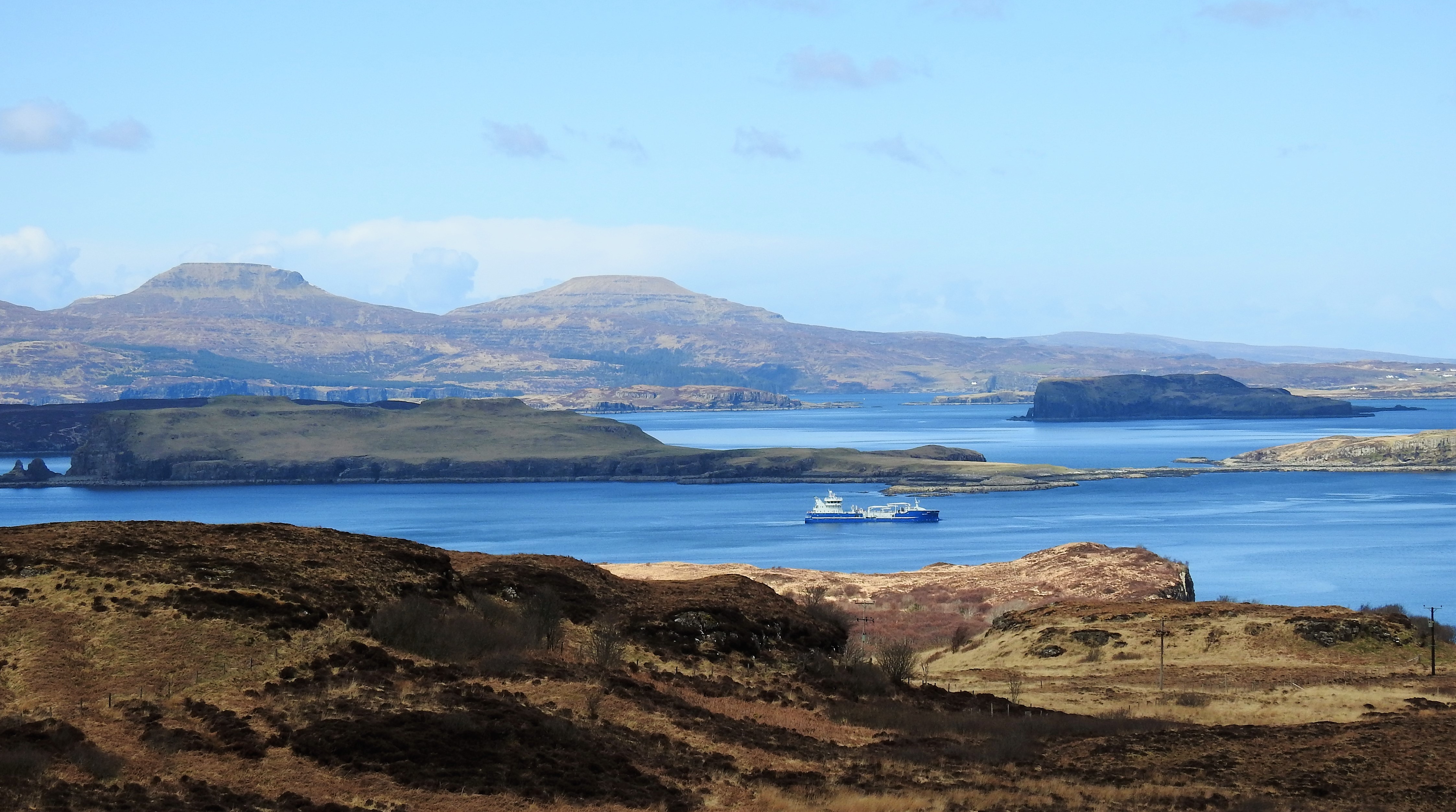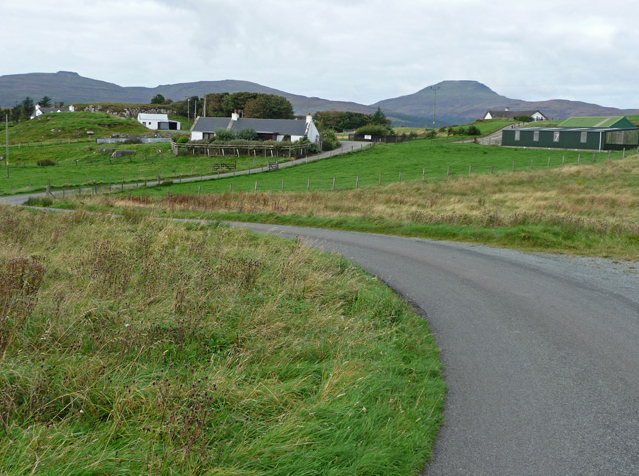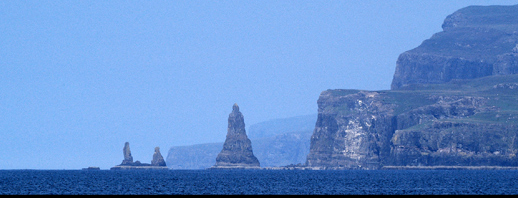|
Oronsay, Loch Bracadale
Oronsay ( gd, Orasaigh) is an uninhabited tidal island in Loch Bracadale on the west coast of Skye, Scotland. It is c.1,000 metres (0.7miles) long by 220m wide running approximately north-east to south west. At low tide (approx. below 4 metres) the island is connected to Ullinish Point on Skye via a narrow rocky causeway, some 200m long. The name Oronsay is believed to derive from the Old Norse for 'tidal island'. The eastern part of the island, which faces Skye, is low-lying grass land, while the western part rises until it reaches several cliffs, up to in height. Views from the westward side are to the Atlantic, Idrigill Point, Macleod's Maidens, with the much larger island of Wiay c.0.8 miles north-west, behind which the flat tops of Healabhal Bheag and Healabhal Mhòr (Macleod's Tables) dominate from the Duirinish Peninsula. Behind Wiay some 2.7miles north-west is Harlosh Island Harlosh Island is one of four islands to be found in Isle of Skye, Skye's Loch Brac ... [...More Info...] [...Related Items...] OR: [Wikipedia] [Google] [Baidu] |
Loch Bracadale
Loch Bracadale (Scottish Gaelic: ''Loch Bhràcadail'') is a sea loch on the west coast of Skye in Scotland. It separates the Minginish Peninsula in the south from the Duirinish Peninsula in the north. Loch Bracadale and its associated inner lochs - Loch Harport, Loch Vatten, Loch Caroy, Loch Bharcasaig, Loch na Faolinn and Loch Beag - form one of the largest areas of semi-enclosed inshore waters around the Skye coast. The shallow waters are used for salmon and mussel farms, crab and lobster creels as well as scallop diving. The loch contains four islands; Harlosh Island, Tarner Island, Wiay and the tidal island of Oronsay off Ullinish point. The mouth of Loch Bracadale (where it opens to the Atlantic) is some wide, from Idrigill Point on the Duirinish Peninsula to Rubha nan Clach on the Minginish Peninsula. west of Idrigill Point are the three sea stacks known as Macleod's Maidens. On the south-western shore of the loch, from Rubha nan Clach are impressive sea cliffs ... [...More Info...] [...Related Items...] OR: [Wikipedia] [Google] [Baidu] |
Healabhal Bheag
Healabhal Bheag is a hill located on the Duirinish peninsula of the Isle of Skye in the Inner Hebrides, Scotland. It is also known as MacLeod's Table South and is part of the prominent pair of peaks known as MacLeod's Tables that dominate the views to the west of Dunvegan Dunvegan ( gd, Dùn Bheagain) is a village on the Isle of Skye in Scotland. It is famous for Dunvegan Castle, seat of the chief of Clan MacLeod. Dunvegan is within the parish of Duirinish, and Duirinish Parish Church is at Dunvegan. In 2011 i ... and to the north of Harlosh.Slesser (1970) p. 178. Notes References * {{Coord, 57.3844, N, 6.6210, W, type:landmark_region:GB, display=title Mountains and hills of the Isle of Skye Marilyns of Scotland ... [...More Info...] [...Related Items...] OR: [Wikipedia] [Google] [Baidu] |
Landforms Of The Isle Of Skye
A landform is a natural or anthropogenic land feature on the solid surface of the Earth or other planetary body. Landforms together make up a given terrain, and their arrangement in the landscape is known as topography. Landforms include hills, mountains, canyons, and valleys, as well as shoreline features such as bays, peninsulas, and seas, including submerged features such as mid-ocean ridges, volcanoes, and the great ocean basins. Physical characteristics Landforms are categorized by characteristic physical attributes such as elevation, slope, orientation, stratification, rock exposure and soil type. Gross physical features or landforms include intuitive elements such as berms, mounds, hills, ridges, cliffs, valleys, rivers, peninsulas, volcanoes, and numerous other structural and size-scaled (e.g. ponds vs. lakes, hills vs. mountains) elements including various kinds of inland and oceanic waterbodies and sub-surface features. Mountains, hills, plateaux, and plains are the fou ... [...More Info...] [...Related Items...] OR: [Wikipedia] [Google] [Baidu] |
Tarner Island
Tarner Island is a triangular shaped island in Loch Bracadale just off the coast off the Harlosh peninsula of Skye in Scotland. It is about in extent and is 0.65 miles at its longest by 0.33 miles at its widest The coastline is largely cliff-lined and rocky however slopes down to the northernmost part of the island at which point it is possible to land by small boat or kayak. Tarner Island is dotted with small sea caves around the perimeter, many large enough to kayak into, and there is a natural arch to the north. The west of the island is dominated by cliffs and a large leaning boulder, known as 'Fingal's Limpet Hammer'. ("''A huge block of trap, which has slipped from the face of a cliff in one of the islands of Loch Bracadale in Skye, is called ' Ord-bàirnich Fhinn,' Fingal's limpet-hammer.''" Tarner Island is 0.5 miles from mainland Skye at its nearest point and there are several skerries including Sgeir Mhòr and Sgeir Bheag that lie just offshore to the north east be ... [...More Info...] [...Related Items...] OR: [Wikipedia] [Google] [Baidu] |
Harlosh
Harlosh ( gd, Heàrrlois) is a settlement on the island of Skye off the west coast of Scotland. The settlement is on a peninsula of the same name. Situated at the end of a narrow peninsula between Lochs Caroy and Bharcasaig (both of which are arms of Loch Bracadale), Harlosh is some from the village of Dunvegan. Harlosh Island and Tarner Island lie just offshore, with Wiay some distant to the south. The name "Harlosh" is of Old Norse origin and may refer to a river mouth, although the meaning is not clear. The ruins of Dun Feorlig broch are just to the north east along the shores of Loch Caroy. This Iron Age structure has an external diameter of and there is little trace of the building except for part of the foundation course. It sits on an elevated rock separated from the surrounding area by a deep hollow that was probably excavated. Dun Reil is a structure of a similar antiquity to the south of Harlosh beyond Camus Ban. The premises of the Isle of Skye Fudge Company ... [...More Info...] [...Related Items...] OR: [Wikipedia] [Google] [Baidu] |
Harlosh Island
Harlosh Island is one of four islands to be found in Isle of Skye, Skye's Loch Bracadale. Harlosh Island is from the coast of the Duirinish, Skye, Duirinish Peninsula and from the coast of the Minginish peninsula. At low tide it is only about from Harlosh Point (between Loch Caroy and Loch Vatten) on mainland Skye. The island is around in area, making it roughly the same size as Tarner Island ( to the east). The coastline, which is largely cliff-lined, has a cave on the west coast. The island is long at its longest and wide at its widest. Harlosh Skerry lies just offshore to the north west, upon which seals can be seen frequently. At low tide on the northern coast there is a large sandy bay, however, watercraft should take caution when attempting to land in the bay as several rock formations pose a navigational hazard at low tide. The name "Harlosh" is of Old Norse origin and may refer to a river mouth, although the meaning is not clear. Notes External links ... [...More Info...] [...Related Items...] OR: [Wikipedia] [Google] [Baidu] |
Duirinish, Skye
Duirinish ( gd, Diùirinis) is a peninsula and Civil parishes in Scotland, civil parish on the island of Skye in Scotland. It is situated in the north west between Loch Dunvegan and Loch Bracadale. Geography Skye's shape defies description and W. H. Murray wrote that "Skye is long, but what might be its breadth is beyond the ingenuity of man to state". Malcolm Slesser suggested that its shape "sticks out of the west coast of northern Scotland like a lobster's claw ready to snap at the fish bone of Harris and Lewis", which would make Duirinish one of the claws. The main peaks are Healabhal Mhòr and Healabhal Bheag, which reach and respectively, and are better known as MacLeod's Tables. They lie in the centre of the peninsula and their distinctive shapes are visible throughout much of north west Skye. Dunvegan Head marks the north end of the peninsula and Idrigill Point the south. The west coast is now uninhabited and offshore there are only a few small islets: An Dubh Sgeir ... [...More Info...] [...Related Items...] OR: [Wikipedia] [Google] [Baidu] |
Healabhal Mhòr
Healabhal Mhòr (471 m), is a hill in the north of the Isle of Skye, Scotland. It is also known as MacLeod's Table North, as it lies close the fellow flat-topped hill of Healabhal Bheag, or MacLeod's Table South. Despite its lower height, it has a greater bulk than its neighbour. The more commonly climbed of the two peaks, walks usually start from the coastal village of Dunvegan Dunvegan ( gd, Dùn Bheagain) is a village on the Isle of Skye in Scotland. It is famous for Dunvegan Castle, seat of the chief of Clan MacLeod. Dunvegan is within the parish of Duirinish, and Duirinish Parish Church is at Dunvegan. In 2011 i .... The summit plateau provides an outstanding view to the Outer Hebrides on a clear day. References Marilyns of Scotland Mountains and hills of the Isle of Skye {{Highland-geo-stub ... [...More Info...] [...Related Items...] OR: [Wikipedia] [Google] [Baidu] |
Wiay, Inner Hebrides
Wiay, pronounced "waya" (Gaelic: Fuidheigh) is an uninhabited island in Loch Bracadale, off the coast of the Isle of Skye Wiay is approximately wide by long and lies west of Ullinish, and north of Fiskavaig on the Minginish Peninsula. It is the largest island in Loch Bracadale, with an area of . Most of the coastline consists of cliffs up to high, and the southern bluff is a striking overhanging cliff of . The highest point of the island is . Wiay is noted for its stunning sea arches and large echoing sea caves, one of which is reputed to be haunted by an English ghost. Geography There are five sea caves, the largest of which are at NG296356 and NG301370, one of which was visited by Johnson and Boswell in September 1773 during their Tour of the Hebrides (see Johnson and Boswell visit''.' below). There is also a natural sea arch at NG358294. One of the few low points to get onto the island is the main bay "Camas na Cille" (meaning ‘Churchyard Bay*’ in Scottish ... [...More Info...] [...Related Items...] OR: [Wikipedia] [Google] [Baidu] |
Skye
The Isle of Skye, or simply Skye (; gd, An t-Eilean Sgitheanach or ; sco, Isle o Skye), is the largest and northernmost of the major islands in the Inner Hebrides of Scotland. The island's peninsulas radiate from a mountainous hub dominated by the Cuillin, the rocky slopes of which provide some of the most dramatic mountain scenery in the country. Slesser (1981) p. 19. Although has been suggested to describe a winged shape, no definitive agreement exists as to the name's origins. The island has been occupied since the Mesolithic period, and over its history has been occupied at various times by Celtic tribes including the Picts and the Gaels, Scandinavian Vikings, and most notably the powerful integrated Norse-Gaels clans of MacLeod and MacDonald. The island was considered to be under Norwegian suzerainty until the 1266 Treaty of Perth, which transferred control over to Scotland. The 18th-century Jacobite risings led to the breaking-up of the clan system and later clearanc ... [...More Info...] [...Related Items...] OR: [Wikipedia] [Google] [Baidu] |
Ullinish
Ullinish (Gaelic: Uilfhinis) is a crofting township on Loch Bracadale, on the southwest coast of Skye, Scotland. The only promontory fort on Skye is located at Ullinish. It is situated to the west of Struan and just south of the hamlet of Ebost. Historically, Ullinish is associated with the MacLeod family. Of literary note, Samuel Johnson's views and denunciation of James Macpherson's ''Ossian'' were confirmed while Johnson was in Ullinish. Etymology The name Ullinish is from Old Norse ''úlfa-nes'', meaning "promontory of the wolves". In Gaelic, it is sometimes spelt as ''Uilinis'' or ''Uilbhinis''. Geography Located on the Inner Hebrides, Ullinish lies on a small peninsula, with a boggy moorland ending at Ullinish Point. Loch Caroy is situated between Ullinish Point and Harlosh Island. The small tidal island of Oronsay is joined to Ullinish Point at low tide, and separated by a breakwater. The town is overlooked by the low, basalt cliffs of the Cuillin Hills, and MacL ... [...More Info...] [...Related Items...] OR: [Wikipedia] [Google] [Baidu] |

.jpg)






